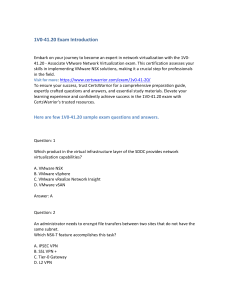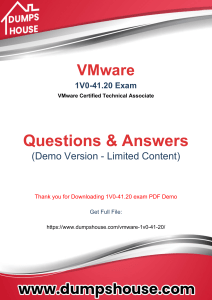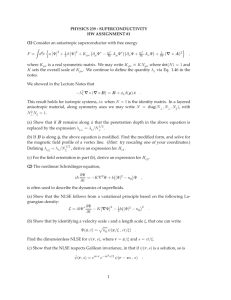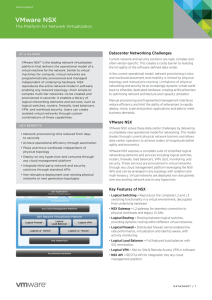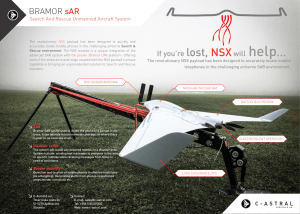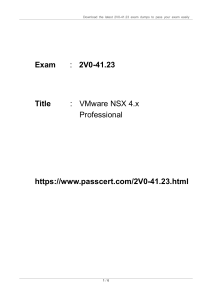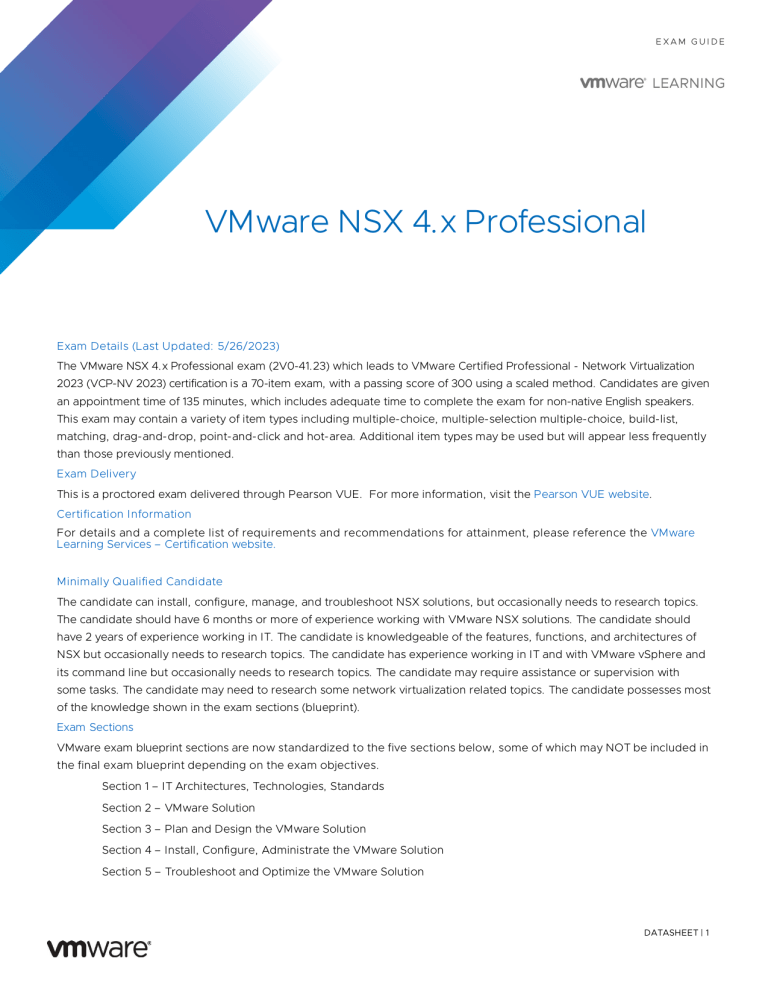
E XAM GUI DE VMware NSX 4.x Professional Exam Details (Last Updated: 5/26/2023) The VMware NSX 4.x Professional exam (2V0-41.23) which leads to VMware Certified Professional - Network Virtualization 2023 (VCP-NV 2023) certification is a 70-item exam, with a passing score of 300 using a scaled method. Candidates are given an appointment time of 135 minutes, which includes adequate time to complete the exam for non-native English speakers. This exam may contain a variety of item types including multiple-choice, multiple-selection multiple-choice, build-list, matching, drag-and-drop, point-and-click and hot-area. Additional item types may be used but will appear less frequently than those previously mentioned. Exam Delivery This is a proctored exam delivered through Pearson VUE. For more information, visit the Pearson VUE website. Certification Information For details and a complete list of requirements and recommendations for attainment, please reference the VMware Learning Services – Certification website. Minimally Qualified Candidate The candidate can install, configure, manage, and troubleshoot NSX solutions, but occasionally needs to research topics. The candidate should have 6 months or more of experience working with VMware NSX solutions. The candidate should have 2 years of experience working in IT. The candidate is knowledgeable of the features, functions, and architectures of NSX but occasionally needs to research topics. The candidate has experience working in IT and with VMware vSphere and its command line but occasionally needs to research topics. The candidate may require assistance or supervision with some tasks. The candidate may need to research some network virtualization related topics. The candidate possesses most of the knowledge shown in the exam sections (blueprint). Exam Sections VMware exam blueprint sections are now standardized to the five sections below, some of which may NOT be included in the final exam blueprint depending on the exam objectives. Section 1 – IT Architectures, Technologies, Standards Section 2 – VMware Solution Section 3 – Plan and Design the VMware Solution Section 4 – Install, Configure, Administrate the VMware Solution Section 5 – Troubleshoot and Optimize the VMware Solution DATASHEET | 1 VMware NSX 4. x Professional If a section does not have testable objectives in this version of the exam, it will be noted below, accordingly. The objective numbering may be referenced in your score report at the end of your testing event for further preparation should a retake of the exam be necessary. Sections Included in this Exam Section 1 – IT Architectures, Technologies, Standards Not Applicable Section 2 – VMware Solution Objective 2.1 - Demonstrate knowledge of VMware Virtual Cloud Network and NSX Objective 2.1.1 Describe the purpose of VMware Virtual Cloud Network and its framework Objective 2.1.2 Identify the benefits and recognize the use cases for NSX Objective 2.1.3 Describe how NSX fits into the NSX product portfolio Objective 2.1.4 Recognize features and the main elements in the NSX Data Center architecture Objective 2.1.5 Describe NSX policy and centralized policy management Objective 2.1.6 Describe the NSX management cluster and the management plane Objective 2.1.7 Identify the functions of control plane components, data plane components, and Objective 2.2 Demonstrate knowledge of NSX Management Cluster Objective 2.2.1 Objective 2.3 Explain the deployment workflows for the NSX infrastructure Demonstrate knowledge of the NSX UI Objective 2.3.1 Objective 2.4 communication channels Distinguish between the Policy and the Manager UI Demonstrate knowledge of the data plane Objective 2.4.1 Describe the functions of transport zones, transport nodes, VDS, and N-VDS Objective 2.4.2 Explain the relationships among transport nodes, transport zones, VDS, and N-VDS Objective 2.4.3 Describe NSX Data Center on VDS Objective 2.4.4 Describe uplink profiles Objective 2.5 Demonstrate knowledge of logical switching Objective 2.5.1 Describe the functions of NSX Data Center segments Objective 2.5.2 Recognize different types of segments Objective 2.5.3 Explain tunneling and the Geneve encapsulation protocol Objective 2.5.4 Describe the interaction between components in logical switching Objective 2.5.5 Describe the function of kernel modules and NSX agents installed on ESXi Objective 2.5.6 Describe the function of the management plane in logical switching Objective 2.5.7 Describe the function of the control plane in logical switching DATASHEET | 2 VMware NSX 4. x Professional Objective 2.6 Demonstrate knowledge of logical switching packet forwarding Objective 2.6.1 Describe the functions of each table used in packet forwarding Objective 2.6.2 Describe how BUM traffic is managed in switching Objective 2.6.3 Explain how ARP suppression is achieved Objective 2.7 Demonstrate knowledge of segments and segment profiles Objective 2.7.1 Define what a segment is Objective 2.7.2 Describe the purpose of segment profiles Objective 2.7.3 Identify the functions of the segment profiles in NSX Objective 2.8 Demonstrate knowledge of logical routing Objective 2.8.1 Explain the function and features of logical routing Objective 2.8.2 Describe the architecture of NSX two-tier routing Objective 2.8.3 Differentiate between north-south and east-west routing Objective 2.8.4 Describe the gateway components Objective 2.8.5 Recognize the various types of gateway interfaces Objective 2.9 Demonstrate knowledge of NSX Edge and Edge Clusters Objective 2.9.1 Explain the main functions and features of the NSX Edge node Objective 2.9.2 Describe the functions of the NSX Edge cluster Objective 2.9.3 Identify the NSX Edge node form factors and sizing options Objective 2.9.4. Describe the different NSX Edge node deployment methods Objective 2.10 Demonstrate knowledge of Tier-0 and Tier-1 Gateways Objective 2.10.1 Describe how to configure a Tier-1 gateway Objective 2.10.2 Explain how to configure a Tier-0 gateway Objective 2.10.3 Explain Active/Active Tier-0 and Tier-1 configurations Objective 2.10.4 Explain multi-tenancy use in a Tier-0 gateway Objective 2.11 Demonstrate knowledge of static and dynamic routing Objective 2.11.1 Objective 2.12 Distinguish between static and dynamic routing Demonstrate knowledge of ECMP and high availability Objective 2.12.1 Explain the purpose of ECMP routing Objective 2.12.2 Identify the active-active and active-standby modes for high availability Objective 2.12.3 Recognize failure conditions and explain the failover process Objective 2.13 Demonstrate knowledge of logical routing packet walk Objective 2.13.1 Describe the datapath of single-tier routing Objective 2.13.2 Explain the datapath of multitier routing Objective 2.14 Demonstrate knowledge of VRF Lite Objective 2.14.1 Describe VRF Lite DATASHEET | 3 VMware NSX 4. x Professional Objective 2.14.2 Explain the benefits of VRF Lite Objective 2.15 Demonstrate knowledge of logical bridging Objective 2.15.1 Describe the purpose and function of logical bridging Objective 2.15.2 Distinguish between routing and bridging Objective 2.16 Demonstrate knowledge of NSX segmentation Objective 2.16.1 Define NSX segmentation Objective 2.16.2 Recognize use cases for NSX segmentation Objective 2.16.3 Identify steps to enforce Zero-Trust with NSX segmentation Objective 2.17 Demonstrate knowledge of distributed firewall Objective 2.17.1 Identify types of firewalls in NSX Objective 2.17.2 Describe features of distributed firewalls Objective 2.17.3 Describe the distributed firewall architecture Objective 2.18 Demonstrate knowledge of security in distributed firewall on VDS Objective 2.18.1 List the distributed firewall on VDS requirements Objective 2.19 Demonstrate knowledge of NSX Gateway Firewall Objective 2.19.1 Describe the functions of the gateway firewall Objective 2.19.2 Explain the purpose of a gateway policy Objective 2.19.3 Describe the gateway firewall architecture Objective 2.20 Demonstrate knowledge of Intrusion Detection and Prevention Objective 2.20.1 Explain NSX IDS/IPS and its use cases Objective 2.20.2 Define the NSX IDS/IPS Detection terminology Objective 2.20.3 Describe the NSX IDS/IPS architecture Objective 2.21 Demonstrate knowledge of NSX Application Platform Objective 2.21.1 Describe NSX Application Platform and its use cases Objective 2.21.2 Explain the NSX Application Platform architecture and services Objective 2.22 Demonstrate knowledge of malware prevention Objective 2.22.1 Identify use cases for malware prevention Objective 2.22.2 Identify the components in the malware prevention architecture Objective 2.22.3 Describe the malware prevention packet flows for known and unknown files Objective 2.23 Demonstrate knowledge of NSX Intelligence Objective 2.23.1 Describe NSX Intelligence and its use cases Objective 2.23.2 Explain NSX Intelligence system requirements Objective 2.23.3 Explain NSX Intelligence visualization, recommendation, and network traffic analysis capabilities Objective 2.24 Demonstrate NSX Network Detection and Response DATASHEET | 4 VMware NSX 4. x Professional Objective 2.24.1 Describe NSX Network Detection and Response and its use cases Objective 2.24.2 Explain the architecture of NSX Network Detection and Response in NSX Objective 2.24.3 Describe the visualization capabilities of NSX Network Detection and Response Objective 2.25 Demonstrate knowledge of NAT and how it is used with NSX Objective 2.25.1 Explain the role of network address translation (NAT) Objective 2.25.2 Distinguish between source and destination NAT Objective 2.25.3 Describe how Reflexive NAT works Objective 2.25.4 Explain how NAT64 facilitates communication between IPv6 and IPv4 networks Objective 2.25.5 Describe stateful active-active NAT operation Objective 2.26 Demonstrate knowledge of DHCP and DNS Objective 2.26.1 Explain how DHCP and DHCP Relay are used for IP address allocation Objective 2.26.2 Configure DHCP services in NSX Objective 2.26.3 Describe how to use a DNS forwarder service Objective 2.27 Demonstrate knowledge of NSX Advanced Load Balancer Objective 2.27.1 Describe NSX Advanced Load Balancer and its use cases Objective 2.27.2 Explain the NSX Advanced Load Balancer architecture Objective 2.27.3 Explain the NSX Advanced Load Balancer components and how they manage traffic Objective 2.28 Demonstrate knowledge of IPSec VPN Objective 2.28.1 Explain how IPSec-based technologies are used to establish VPNs Objective 2.28.2 Compare policy-based and route-based IPSec VPN Objective 2.28.3 Describe IPSec VPN requirements in NSX Objective 2.29 Demonstrate knowledge of L2 VPN Objective 2.29.1 Describe L2 VPN technologies in an NSX Objective 2.29.2 Identify various supported L2 VPN endpoints Objective 2.30 Demonstrate knowledge of integrating NSX with VMware Identity Manager Objective 2.30.1 Describe the purpose of VMware Identity Manager Objective 2.30.2 Identify the benefits of integrating NSX with VMware Identity Manager Objective 2.31 Demonstrate knowledge of integrating NSX with LDAP Objective 2.31.1 Identify the benefits of integrating NSX with LDAP Objective 2.31.2 Describe the LDAP authentication architecture Objective 2.32 Demonstrate knowledge of managing users and configuring RBAC Objective 2.32.1 Identify the different types of users in NSX Objective 2.32.2 Recognize permissions and roles available in NSX Objective 2.33 Demonstrate knowledge of Federation Architecture, needed prerequisites, Federation Networking, and Federation Security DATASHEET | 5 VMware NSX 4. x Professional Objective 2.33.1 Describe Federation and its use cases Objective 2.33.2 Describe the requirements and limitations of Federation Objective 2.33.3 Describe the Federation configuration workflow Objective 2.33.4 Describe the prerequisites for Federation Objective 2.33.5 Describe the onboarding of Local Manager configurations and workloads Objective 2.33.6 Describe the stretched networking concepts in Federation Objective 2.33.7 Explain the supported Tier-0 and Tier-1 stretched topologies Objective 2.33.8 Explain Layer 2 concepts related to NSX Federation Objective 2.33.9 Explain the Federation security use cases Objective 2.33.10 Describe the Federation security components Objective 2.33.11 Explain the security configuration workflows Objective 2.34 Demonstrate knowledge of DPU-based acceleration for NSX Section 3 – Plan and Design the VMware Solution Not Applicable Section 4 – Install, Configure, Administrate the VMware Solution Objective 4.1 - Prepare an NSX infrastructure for deployment Objective 4.1.1 Create Transport Zones Objective 4.1.2 Create IP Pools Objective 4.1.3 Prepare ESXi Hosts Objective 4.2 Configure segments Objective 4.2.1 Create segments Objective 4.2.2 Attach VMs to segments Objective 4.2.3 Use network topology to validate the logical switching configuration Objective 4.3 Deploy and configure NSX Edge Nodes Objective 4.3.1 Deploy NSX Edge Nodes Objective 4.3.2 Configure an Edge Cluster Objective 4.4 Configure the Tier-1 gateway Objective 4.4.1 Create a Tier-1 gateway Objective 4.4.2 Connect segments to the Tier-1 gateway Objective 4.4.3 Use network topology to validate the Tier-1 gateway configuration Objective 4.5 Create and configure a Tier-0 gateway with OSPF Objective 4.5.1 Create uplink segments Objective 4.5.2 Create a Tier-0 gateway DATASHEET | 6 VMware NSX 4. x Professional Objective 4.5.3 Connect the Tier-0 and Tier-1 gateways Objective 4.5.4 Use network topology to validate the Tier-0 gateway configuration Objective 4.6 Configure the Tier-0 gateway with BGP Objective 4.6.1 Create uplink segments Objective 4.6.2 Create a Tier-0 gateway Objective 4.6.3 Connect the Tier-0 and Tier-1 gateways Objective 4.6.4 Use network topology to validate the Tier-0 gateway configuration Objective 4.7 Configure VRF Lite Objective 4.7.1 Create the uplink trunk segment Objective 4.7.2 Deploy and configure the VRF gateways Objective 4.7.3 Deploy and connect the Tier-1 gateways to the VRF gateways Objective 4.7.4 Create and connect segments to the Tier-1 gateways Objective 4.7.5 Attach VMs to segments on each VRF Objective 4.7.6 Review the routing tables in each VRF Objective 4.8 Configure the NSX Distributed Firewall Objective 4.8.1 Create security group Objective 4.8.2 Create Distributed Firewall rules Objective 4.9 Configure the NSX Gateway Firewall Objective 4.9.1 Objective 4.10 Configure a gateway firewall rule to block external SSH requests Configure Intrusion Detection Objective 4.10.1 Enable Distributed Intrusion Detection and Prevention Objective 4.10.2 Download the Intrusion Detection and Prevention signatures Objective 4.10.3 Create an Intrusion Detection and Prevention profile Objective 4.10.4 Configure Intrusion Detection rules Objective 4.10.5 Configure North-South IDS/IPS Objective 4.10.6 Create a segment and attach a VM Objective 4.10.7 Analyze Intrusion Detection events Objective 4.10.8 Modify the IDS/IPS settings to prevent malicious traffic Objective 4.10.9 Analyze Intrusion Prevention events Objective 4.11 Deploy NSX Application Platform Objective 4.12 Configure malware prevention for East-West and North-South Traffic Objective 4.13 Use NSX Network Detection and Response to detect threats Objective 4.14 Configure Network Address Translation Objective 4.14.1 Create a Tier-1 gateway for Network Address Translation Objective 4.14.2 Create a segment DATASHEET | 7 VMware NSX 4. x Professional Objective 4.14.3 Attach a VM to NAT segment Objective 4.14.4 Configure NAT Objective 4.14.5 Configure NAT route redistribution Objective 4.15 Configure NSX Advanced Load Balancer Objective 4.15.1 Create segments for the NSX Advanced Load Balancer Objective 4.15.2 Deploy the NSX Advanced Load Balancer controller Objective 4.15.3 Access the NSX Advanced Load Balancer UI Objective 4.15.4 Create a Cloud Connector for NSX Objective 4.15.5 Configure Service Engine Networks and Routing Objective 4.15.6 Create a virtual service Objective 4.15.7 Configure route advertisement and route redistribution for a virtual IP Objective 4.16 Deploy Virtual Private Networks Objective 4.16.1 Deploy a new NSX Edge Node to support a VPN deployment Objective 4.16.2 Configure a new Edge Cluster Objective 4.16.3 Deploy and configure a new Tier-0 gateway and segments for VPN support Objective 4.16.4 Create an IPSec VPN service Objective 4.16.5 Create an L2 VPN server and session Objective 4.16.6 Configure a pre-deployed autonomous Edge as an L2 VPN client Objective 4.17 Manage users and roles Objective 4.17.1 Add an Active Directory Domain as an identity source Objective 4.17.2 Assign NSX roles to domain users and validate permissions Objective 4.17.3 Modify an existing role and validate the role permissions Objective 4.18 Perform operations tasks in a VMware NSX environment (syslog, backup/restore etc.) Objective 4.19 Monitor a VMware NSX implementation Section 5 – Troubleshoot and Optimize the VMware Solution Objective 5.1 – Use log files to troubleshoot issues Objective 5.1.1 Identify the default log file locations of NSX components Objective 5.1.2 Generate Log Bundles Objective 5.1.3 Use log files to help identify NSX issues Objective 5.2 Identify Tools Available for Troubleshooting Issues Objective 5.3 Troubleshoot Common NSX Issues Objective 5.3.1 Troubleshoot Common NSX Installation/Configuration Issues Objective 5.3.2 Troubleshoot Common NSX Component Issues DATASHEET | 8 VMware NSX 4. x Professional Objective 5.3.3 Troubleshoot Common Connectivity Issues Objective 5.3.4 Troubleshoot Common physical infrastructure Issues DATASHEET | 9 VMware NSX 4. x Professional Courses used to develop this exam and strongly recommended to you for exam preparation: VMware NSX: Install, Configure, Manage [V4. 0] Certification Requirements VCP-NV 2023 References No additional resources. Exam Contributors Ross Wynne Chand Basha Shaik Rick Watson Abdullah Abdullah Jennifer Schmidt Iwan Hoogendoorn Tim Burkard Tobias Paschek Marco van Baggum Reinhard Partman Ronak Patel Tommy Grot Karel Novak Christian Parker Arantxa Duque Barrachina Jiri Viktorin Jens Hennig Nicola Marco Decandia VMware, Inc. 3401 Hillview Avenue Palo Alto CA 94304 USA Tel 877-486-9273 Fax 650-427-5001 www.vmware.com © 2023 VMware, Inc. All rights reserved. The product or workshop materials is protected by U.S. and international copyright and intellectual property laws. VMware products are covered by one or more patents listed at http://www.vmware.com/download/patents.html. VMware is a registered trademark or trademark of VMware, Inc. in the United States and/or other jurisdictions. All other marks and names mentioned herein may be trademarks of their respective companies. VMware warrants that it will perform these workshop services in a reasonable manner using generally accepted industry standards and practices. THE EXPRESS WARRANTY SET FORTH IS IN LIEU OF ALL OTHER WARRANTIES, EXPRESS, IMPLIED, STATUTORY OR OTHERWISE INCLUDING IMPLIED WARRANTIES OF MERCHANTABILITY OR FITNESS FOR A PARTICULAR PURPOSE WITH RESPECT TO THE SERVICES AND DELIVERABLES PROVIDED BY VMWARE, OR AS TO THE RESULTS WHICH MAY BE OBTAINED THEREFROM. VMWARE WILL NOT BE LIABLE FOR ANY THIRD-PARTY SERVICES OR PRODUCTS IDENTIFIED OR REFERRED TO CUSTOMER. All materials provided in this workshop are copyrighted by VMware ("Workshop Materials"). VMware grants the customer of this workshop a license to use and make reasonable copies of any Workshop Materials strictly for the purpose of facilitating such company's internal understanding, utilization and operation of its licensed VMware product(s). Except as set forth expressly in the sentence above, there is no transfer of any intellectual property rights or any other license granted under the terms of this workshop. If you are located in the United States, the VMware contracting entity for the service will be VMware, Inc., and if outside of the United States, the VMware contracting entity will be VMware International Limited. REV. 7/2023
